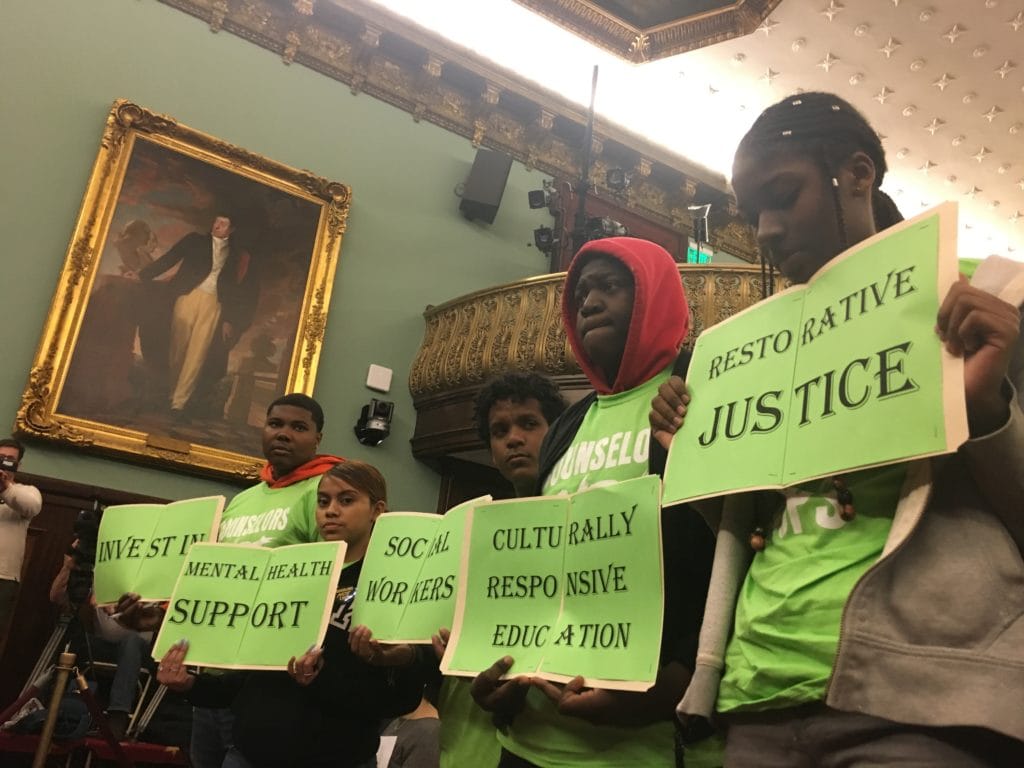‘Everything is on the table’ — Carranza talks budget cuts to NYC schools at City Council hearing


By Alex Zimmerman, Chalkbeat NY
During a whirlwind budget hearing, Chancellor Richard Carranza said he is considering a wide range of budget cuts, defended staffing schools with more safety officers than counselors, and said a long-awaited agreement with the police department on school safety is being “finalized.”
Wednesday’s budget hearing comes as the education department is being asked to find $104 million in budget cuts, partly the result of a projected shortfall in income tax revenue.
Those cuts represent a small fraction of the department’s nearly $27 billion preliminary budget, but Carranza said no program is completely safe, including core initiatives such as expanded AP classes, literacy coaches, and even individual school budgets.
“Everything is on the table,” he said, adding, “schools are last.”
But the chancellor’s testimony touched numerous hot button issues beyond funding. Here’s what else we learned at Wednesday’s City Council hearing:
Carranza supports more counselors for students in temporary housing… but doesn’t explain why it’s not in the budget
As the city faces a record number of homeless students, Mark Treyger, chairman of the council’s education committee, pressed Carranza on why the mayor left out $14 million in funding for current social workers working with students in temporary housing.
“We are very supportive of those resources” Carranza said, adding that the city is using $12 million in federal funds to support 100 “coordinators” for homeless students. Still, he did not say why the social workers were left out.
The issue has puzzled observers. The funding has been initially left out in previous budget cycles, but is typically added back at the last minute.
this has weirdly become a ‘budget dance’ issue for de Blasio, aka something he doesn’t really plan to cut but seemingly cuts to have the fight https://t.co/OPIfnCvzoc
— Ben Max (@TweetBenMax) March 20, 2019
‘Counselors not cops’ is a rallying cry among advocates. Carranza calls it a ‘false narrative.’
Student justice advocates have repeatedly pointed out that there are more school safety agents, employed by the police department, in schools than guidance counselors, social workers, and psychologists combined. Dozens of students attended the hearing wearing green T-shirts that read “counselors not cops.”
But Carranza said that is a “false narrative.”
“I think it’s the wrong conversation to have about the number of safety agents you have. It’s not an issue until, God forbid, something happens in our schools,” he said.

The comments are surprising given Carranza’s commitment to policies that are designed to reduce suspensions, student arrests, and summonses. Still, Carranza emphasized that he is generally supportive of hiring more counselors in schools.
Carranza had a hand in delaying a new agreement between the police and education departments
For more than a year, top city officials have said they are close to releasing a new agreement between the NYPD and education department — a document that has not been updated since Rudy Giuliani was mayor.
Carranza said he took issue with an earlier draft. “I was not satisfied with what I saw was developing,” he said. Asked about his objections, he said, “There was a lot in that [agreement] that was very much law-enforcement centric. We’ve been pushing back and we’ve actually been having great conversations with NYPD.”
Advocates who played a role in crafting a new agreement have also said an earlier draft appeared to strip their recommendations that would have limited police activities in schools.
On Wednesday, Carranza said the agreement is in its “final stages.”
No specifics on how the department is measuring the impact of core initiatives
How is the city measuring its “Equity and Excellence” initiatives, the backbone of Mayor Bill de Blasio’s education agenda, including computer science, literacy coaches, and expanded AP classes?
Carranza did not offer details, beyond test scores, graduation rates, and college enrollment — generally considered indicators of the school system’s overall health, but tricky measures of specific programs. In recent years, the department has struggled to articulate coherent metrics for some of its biggest programs, while others have yielded disappointing results.
Treyger suggested a more systematic review to “see whether these investments are having their intended impact.”
Chalkbeat is a nonprofit news site covering educational change in public schools.




